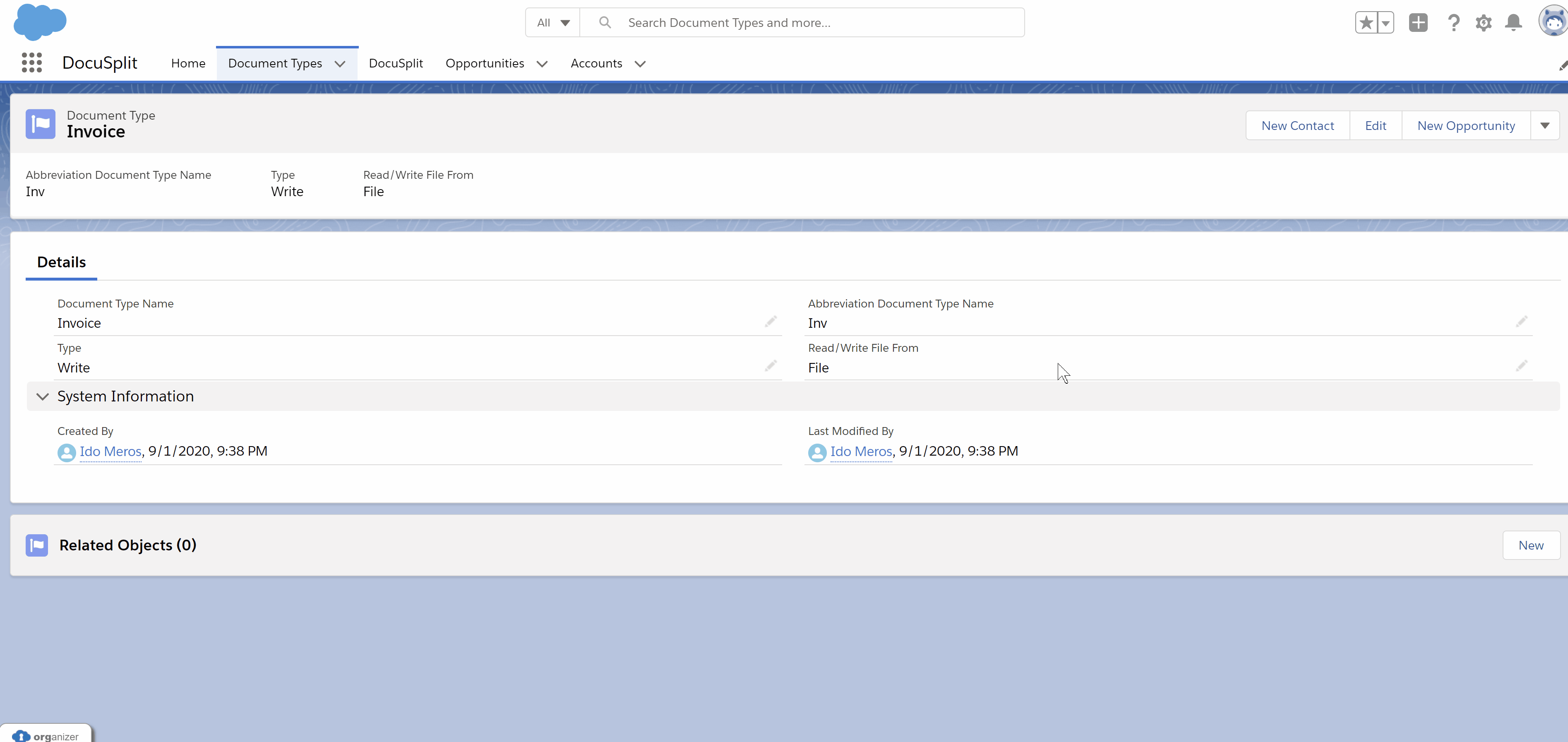Configuration of Related Objects
Configuring Related Objects for Corresponding Document Types
Related Objects Explained
Related Objects allows Administrators to define where specific Document Types will be saved to or imported from, the file naming convention used when saving the documents, the meta keywords related to the file, and the default file type.
Creation of Related Records
To create Related Objects, navigate to the Document Type record created and:
- Click "New" on the Related Object grid.
- Input the values of all fields.
- Click "Save"

Field Definitions:
In the below grid, you will find the description of each field that is required within the Related Object record.
Field Name | Description |
|---|---|
Document Type | This field contains the Relationship to the Document Type created by the user. This should auto-populate if clicking on "New" from within the Document Type. |
Object Name | The Object Name field must contain a valid Salesforce Object API Name. This field will determine where a Document will be imported from or saved to. For instance, if a Salesforce Administrator wanted his/her users to save scanned invoices to a custom object named "purchase orders", he/she would place "purchase_ordersc" within this field. As another example, if files were being received into an email queue in Salesforce name "email queue", the API name may be "email_queuec". |
Default File Name | To streamline and standardize the saving process, this field is used to create a file naming convention. For example, if the Salesforce Administrator wanted to ensure invoices saved to Salesforce records are saved as "Invoice09-01-2020_ABC_Company" they would use the combination of available tokens and static data within this field. The example above would look like this: "Invoice{!TODAY}_{!Company_Name__c}". Available tokens are defined below. |
Default File Type | Options: |
Meta Keyword | Meta Keywords are keywords that can be used to search for files within the general search field. Similar to the Default File Name field, Salesforce Administrators can set the default keywords statically or dynamically using the available tokens. |
Default File Name and Meta Keyword Tokens
Tokens can be used to dynamically set the values of both the file naming convention and meta keyword searches. See the below token descriptions for more details.
Token | Description |
|---|---|
{!DocumentAbbreviation} | Using the DocumentAbbreviation token will place the Document Abbreviation value within the file naming convention or meta keyword. For example, if the Default File Name was "{!DocumentAbbreviation}_{!Company_Name__c}" and the Document Abbreviation set up by the Administrator was "Inv", the value of the file name would be "Inv_ABC_Company". |
{!Field} | The Field Token is not to be used as is but is to be replaced with standard API record fields. An example would be {!Name} or {!Id}. For example, if the Default File Name was "{!DocumentAbbreviation}_{!Name}" and the Object Name was "Account", and the record selected by the user upon saving an invoice was "ABC Company", the Default File Name would be "Inv_ABC Company". |
{!CustomField__c} | Similar to the Field Token, the Custom Field is not to be used as is but is to be replaced with custom API record fields. An example would be {!Balancec} or {!Original_Balancec}. For example, if the Default File Name was "{!DocumentAbbreviation}_{!Balance__c}" and the Object Name was "Invoice", and the record selected by the user upon saving an invoice had a balance of "1000", the Default File Name would be "Inv_1000". |
{!NOW} | Using the NOW token will place the following values within the file naming convention or meta keyword: yyyy-MM-dd HH:mm:ss |
{!TIME} | Using the TIME token will place the following values within the file naming convention or meta keyword: HH:mm:ss |
{!TODAY} | Using the TODAY token will place the following values within the file naming convention or meta keyword: *yyyy-MM-dd |
{!PAGENUMBER} | When using the "Single Page" options for Default File Type, the page number will appear in the file name in the order in which the files were saved. For example, if a user was saving a 3-page document, three files will be created with the value "1", "2" and "3" in place of the token (i.e. Invoice_1, Invoice_2, Invoice_3 where the Default File Name is "Invoice__{!PAGENUMBER}). |
{!TOTALPAGE} | When using the "Single Page" options for Default File Type, the total number of pages will appear in the file name. For example, if a user was saving a 3-page document, three files will be created with the value "3" in place of the token (i.e. Invoice1_of_3, Invoice_2_3, Invoice_3_3 where the Default File Name is "Invoice__{!PAGENUMBER_of{!TOTALPAGE}). |
Next Steps
As a next step in the Document Type configuration process, we must now create Display Field records. For detailed information on the creation of this record type, please see the next section, labeled Configuration of Display Fields.
Updated 9 months ago